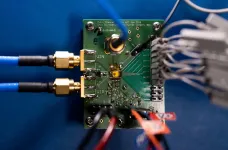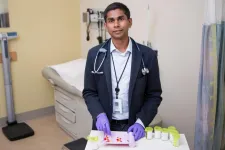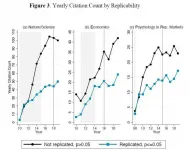Researchers create world's most power-efficient high-speed ADC microchip
Analag-to-digital converters are a key component of nearly every piece of electronic equipment
2021-05-21
(Press-News.org) To meet soaring demand for lightning-quick mobile technology, each year tech giants create faster, more powerful devices with longer-lasting battery power than previous models.
A major reason companies like Apple and Samsung can miraculously pull this off year after year is because engineers and researchers around the world are designing increasingly power-efficient microchips that still deliver high speeds.
To that end, researchers led by a team at Brigham Young University have just built the world's most power-efficient high-speed analog-to-digital converter (ADC) microchip. An ADC is a tiny piece of technology present in almost every electronic piece of equipment that converts analog signals (like a radio wave) to a digital signal.
The ADC created by BYU professor Wood Chiang, Ph.D. student Eric Swindlehurst and their colleagues consumes only 21 milli-Watts of power at 10GHz for ultra-wideband wireless communications; current ADCs consume hundreds of milli-Watts or even Watts of power at comparable speeds. The BYU-made ADC has the highest power efficiency currently available globally, a record it holds by a substantial margin.
"Many research groups worldwide focus on ADCs; it's like a competition of who can build the world's fastest and most fuel-efficient car," Chiang said. "It is very difficult to beat everyone else around the world, but we managed to do just that."
The central challenge facing researchers like Chiang is that increasingly higher bandwidths within communications system devices means circuits that consume more power. Chiang, Swindlehurst and their team set out to solve the problem by focusing on a key part of the ADC circuit called the DAC, which is a central piece that stands for the exact reverse of ADC: digital-to-analog converter.
For the technologically savvy, here's a broad explanation of what the research team did:
They made the converter faster and more efficient by reducing the loading from the DAC by scaling both the capacitor parallel plate area and spacing. They also grouped unit capacitors differently from the conventional way, grouping together unit capacitors that are part of the same bit in the DAC rather than having them be interleaved throughout. Doing so lowered the bottom-plate parasitic capacitance by three times, significantly lowering power consumption while increasing speed.
Finally, they used a bootstrapped switch, but improved on it by making it dual path where each path can be independently optimized. This method increases the speed but doesn't require additional hardware because it involves splitting existing devices and making route changes in the circuit.
The project, sponsored by the Ministry of Science in Taiwan and a consortium of technology companies, took four years to complete -- three years to design the chip and one year to test it. The team, which included collaborators from National Yang Ming Chiao Tung University in Taiwan and the University of California, Los Angeles, published details of the project in IEEE Journal of Solid-State Circuits earlier this year, with Swindlehurst serving as principal author.
"We've proven the technology of the chip here at BYU and there is no question about the efficacy of this particular technique," Chiang said. "This work really pushes the envelope of what's possible and will result in a lot of conveniences for consumers. Your Wi-Fi will continue to get better because of this technology, you'll have faster upload and download speeds and you can watch 4K or even 8K with little to no lag while maintaining battery life."
Chiang said other likely applications for the ADC include autonomous vehicles (which use a ton of wireless bandwidth), smart wearables like glasses or smart contact lenses, and even things such as implantable devices.
The device required sophisticated design and verification to ensure that all the thousands of connections in the converter would work correctly. A single mistake in the design would have taken at least an additional year to correct, so the team was thrilled to have made no mistakes.
"It's like building a little city. There are so many details that went into this project," Chiang said. "The student team did a marvelous job -- all the pieces fit perfectly together to realize this engineering feat. I am fortunate to have worked with such talented students at BYU."
INFORMATION:
Co-authors on the published research include Hunter Jensen (BYU), Alexander Petrie (BYU), Yixin Song (BYU), Yen-Cheng Kuan (National Yang Ming Chiao Tung University), Yong Qu (Texas Instruments), Mau-Chung Frank Chang (UCLA), Jieh-Tsorng Wu (National Yang Ming Chiao Tung University).
[Attachments] See images for this press release:

ELSE PRESS RELEASES FROM THIS DATE:
2021-05-21
For decades scientists have been puzzled by the formation of rare hyper-enriched gold deposits in places like Ballarat in Australia, Serra Palada in Brazil, and Red Lake in Ontario. While such deposits typically form over tens to hundreds of thousands of years, these "ultrahigh-grade" deposits can form in years, month, or even days. So how do they form so quickly?
Studying examples of these deposits from the Brucejack Mine in northwestern British Columbia, McGill Professor Anthony Williams-Jones of the Department of Earth and Planetary Sciences and PhD student Duncan McLeish have discovered that these gold deposits form much like soured milk. When milk goes sour, the butterfat particles clump together to form a jelly.
Q&A with Anthony Williams-Jones and Duncan McLeish
What did you ...
2021-05-21
A team of researchers led by scientists at UC Santa Cruz analyzed data from 3,212 camera traps to show how human disturbance could be shifting the makeup of mammal communities across North America.
The new study, published in the journal Global Change Biology, builds upon the team's prior work observing how wildlife in the Santa Cruz Mountains respond to human disturbance. Local observations, for example, have shown that species like pumas and bobcats are less likely to be active in areas where humans are present, while deer and wood rats become bolder and more active. But it's difficult to generalize findings like these across larger geographic areas because human-wildlife interactions are often regionally unique.
So, to get a continent-wide ...
2021-05-21
Free access to essential medicines increases patient adherence to taking medication by 35 per cent and reduces total health spending by an average of over $1,000 per patient per year, according to a two-year study that tested the effects of providing patients with free and convenient access to a carefully selected set of medications.
The findings, published May 21 in PLOS Medicine, come as advocates urge Canada to carve a path toward single-payer, public pharmacare. Canada is the only country with universal healthcare that does not have a universal pharmacare program.
A group of researchers led by St. Michael's Hospital of Unity Health ...
2021-05-21
Papers in leading psychology, economic and science journals that fail to replicate and therefore are less likely to be true are often the most cited papers in academic research, according to a new study by the University of California San Diego's Rady School of Management.
Published in Science Advances, the paper explores the ongoing "replication crisis" in which researchers have discovered that many findings in the fields of social sciences and medicine don't hold up when other researchers try to repeat the experiments.
The paper reveals that findings from studies that ...
2021-05-21
The human body is constantly exposed to various environmental actors, from viruses to bacteria to fungi, but most of these microbial organisms provoke little or no response from our skin, which is charged with monitoring and protecting from external dangers.
Until now, researchers weren't quite sure how that happened -- and why our skin wasn't constantly alarmed and inflamed.
In a study published May 21, 2021 in Science Immunology, scientists at University of California San Diego School of Medicine identify and describe two enzymes responsible for protecting our skin and body's overall health from countless potential microbial intruders. These enzymes, called histone deacetylases (HDACs), inhibit the body's inflammatory response in the skin.
"We have figured ...
2021-05-21
Ionization energy is one of the most important physicochemical parameters. It is defined in terms of the amount of energy required to rip an electron from an atom. The dependence of the ionization energy on the atomic number determines the periodic law of chemical elements, which is assumed to be fundamentally constant. Based on the previously predicted effect of changing the electron mass, the research team showed that the ionization energy of atoms placed in photonic crystals with an ultrahigh refractive index can be significantly changed.
Photonic crystals ...
2021-05-21
Despite the increasing frequency and severity of floods, storms, wildfires and other natural hazards, some firms in disaster-prone areas prepare while others do not.
That issue was examined in a new study by Jennifer Oetzel, professor, American University and Chang Hoon Oh, William & Judy Docking Professor of Strategy, University of Kansas published in the Strategic Management Journal (SMJ).
"Due to the increased frequency and severity of floods, storms, epidemics, wildfires and other natural hazards anticipated over the coming decades (according to the National Oceanic and Atmospheric Administration), there is growing pressure on managers and their ...
2021-05-21
DALLAS - May 21, 2021 - One member of a large protein family that is known to stop the spread of bacterial infections by prompting infected human cells to self-destruct appears to kill the infectious bacteria instead, a new study led by UT Southwestern scientists shows. However, some bacteria have their own mechanism to thwart this attack, nullifying the deadly protein by tagging it for destruction.
The findings, published online today in Cell, could lead to new antibiotics to fight bacterial infections. And insight into this cellular conflict could shed light on a number of other conditions in which this protein is involved, including asthma, Type 1 diabetes, primary biliary cirrhosis, and Crohn's disease.
"This ...
2021-05-21
OKLAHOMA CITY AND DENMARK - Campylobacter infection, one of the most common foodborne illnesses in the Western world, can also be spread through sexual contact, according to a new research discovery by an OU Hudson College of Public Health faculty member, working in conjunction with colleagues in Denmark.
The team's research has been published in Emerging Infectious Diseases, a journal published by the Centers for Disease Control and Prevention (CDC), and is the first known study to prove this mode of transmission for Campylobacter. During a time when COVID-19 has dominated news about infectious diseases, the research is a reminder that many other pathogens affect lives around the world every day. The study was led by infectious disease epidemiologist Katrin ...
2021-05-21
Over 20 Indonesian islands mysteriously disappear. One of the world's deadliest criminal syndicates rises to power. Eight cities the size of New York will be built every year for the next three decades. What connects them is sand, embedded in the concrete of nearly all of the world's buildings, roads, and cities, the glass in the windows, laptops and phone screens, and COVID-19 vaccine vials.
The unexamined true costs of sand - broadly, construction aggregates production -- has spurred a group of scientists to call for a stronger focus on understanding the physical dimension of sand use and extraction. They also suggest new ways to achieve economic and environmental justice.
Four years ago, an international group of scientists, including two from Michigan State University (MSU), called ...
LAST 30 PRESS RELEASES:
[Press-News.org] Researchers create world's most power-efficient high-speed ADC microchip
Analag-to-digital converters are a key component of nearly every piece of electronic equipment







